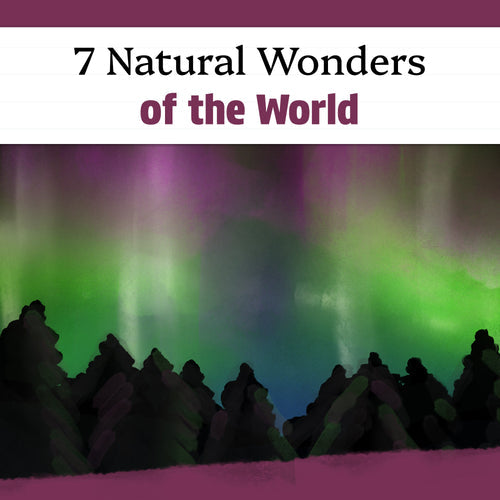Did you know that New Mexico is known as the Land of Volcanoes? This state is home to hundreds of volcanoes, lava flows, and calderas, making it a fascinating place to explore geology! From towering extinct volcanoes to rugged lava fields, the landscape tells the story of ancient eruptions that helped shape the land we see today. Let’s dive into some volcanic terms! Learn more about volcanoes below, and don't forget to grab our Four Quick Facts about Volcanoes printable!
Volcanic Terms
Features of a Volcano
At first glance, a volcano might look like an ordinary mountain, but it has several distinctive features that make it unique. These features help shape the volcano and control the way it erupts.

- vent: The vent is the opening at the top of the volcano where magma escapes and becomes lava during an eruption. This is where the explosive or flowing activity happens, with gases, ash, and lava bursting out. Some volcanoes have multiple vents, which can cause eruptions from different parts of the volcano.
- magma chamber: Beneath the Earth's surface lies the magma chamber, a large, underground pocket where magma collects and resides before it’s pushed up during an eruption. The magma chamber is under high pressure, and when this pressure becomes too great, it forces the magma through the conduit to the surface. The size of the magma chamber can impact the strength and frequency of eruptions.
- conduit: The conduit is the vertical tunnel that connects the magma chamber to the vent at the surface. It is through this passage that magma moves upward and is eventually released as lava. The shape and size of the conduit play a role in determining how explosive or gentle an eruption will be—narrow conduits lead to more violent eruptions, while wider ones allow for smoother lava flows.
Types of Volcanoes
Each type of volcano has a unique role in shaping the Earth's surface, with eruptions ranging from small cinder explosions to massive lava flows. There are three main types of volcanoes, each with a distinct shape, eruption style, and characteristics.
- cinder cone: Cinder cone volcanoes are the smallest type and are often found in groups. They have steep sides formed by the accumulation of loose cinders, ash, and volcanic rock fragments around a single vent. These volcanoes form quickly, usually after a short period of explosive eruptions. Because of their frequent but relatively small eruptions, cinder cones are the most common type of volcano. A well-known example is Parícutin in Mexico, which famously emerged from a cornfield in 1943.

- composite volcano (stratovolcano): Composite volcanoes, also called stratovolcanoes, are much larger than cinder cones and have a more complex structure. They are characterized by alternating layers of hardened lava, ash, and volcanic debris. These volcanoes are known for their powerful, often explosive eruptions that can send ash clouds high into the atmosphere and trigger pyroclastic flows. Famous stratovolcanoes include Mount St. Helens in the United States, which dramatically erupted in 1980, and Mount Fuji in Japan.

- shield volcano: Shield volcanoes are the largest type, with broad, gently sloping sides that resemble a warrior’s shield. They are formed by highly fluid lava that flows over long distances, creating wide, low mountains. Unlike composite volcanoes, shield volcanoes tend to have frequent but mild eruptions. Instead of explosive ash clouds, they produce rivers of lava that can reshape the landscape over time. The largest volcano on Earth—Mauna Loa in Hawai'i—is a classic example of a shield volcano.
Volcanic Activity
Volcanoes can be classified based on their level of activity. Some are constantly erupting, some are sleeping for now, and some are considered permanently quiet. There are three main classifications of volcanoes based on their activity.
- active: If a volcano is in the process of erupting or has erupted in the recent past, it’s said to be an active volcano (such as Kīlauea in Hawaiʻi, one of the most active volcanoes in the world).
- dormant: When a volcano isn’t currently erupting but potentially could in the future, it is considered dormant (such as Mauna Kea in Hawaiʻi, which hasn’t erupted in at least 4,000 years).
- extinct: An extinct volcano is unlikely to ever erupt again (such as Mount Sutter Buttes in California, which has an ancient volcanic structure that will never erupt again).
Things Volcanoes Eject
Lots of people think that lava pours out when volcanoes erupt. But in reality, volcanoes can eject several different materials, each playing a key role in the eruption process. Here's a look at what volcanoes release during an eruption.

- ash: Ash consists of tiny particles of volcanic rock and glass that are blasted high into the air. Ash clouds can travel for miles, causing disruption to air travel and even affecting the climate by blocking sunlight.

- magma: Magma is the molten rock beneath the Earth's surface. Once the magma erupts and flows out of the volcano, it is referred to as lava. Lava can flow slowly or quickly, depending on its composition, and can form lava fields or build up the volcano's layers.

- gases: Volcanic eruptions release a variety of gases, including water vapor, carbon dioxide, and sulfur dioxide. These gases can be harmful; in large quantities they contribute to air pollution, acid rain, and even global cooling.

- rock fragments: Fragments consist of larger pieces of solidified lava and volcanic rock that are thrown from the volcano during an eruption. They can range in size from small pebbles to massive boulders and can cause damage to nearby areas.
What Is Lava Flow?
When a volcano erupts and the magma shoots out of the vent, lava begins to flow down the outside of the volcano. As the red-hot lava cools, it hardens into what’s known as lava flow. There are different types of lava flow, too.
- ‘a‘a flow: identified by its sharp and jagged surface
- pāhoehoe flow: identified by its smooth surface with wavy patterns
- blocky flow: identified by its thick and blocky surface
Famous Volcanoes
Some volcanoes have made history for their size or for their famous eruptions.
- Mount Vesuvius in Italy is a massive volcano responsible for destroying the ancient cities of Pompeii and Herculaneum.
- Krakatoa in Indonesia is known for its huge eruption in 1883 that could be heard from thousands of miles away.
- Capulin Volcano in New Mexico is a well-preserved cinder cone volcano that offers stunning views of a volcanic field from its summit and is part of the Capulin Volcano National Monument.

- Mount St. Helens in Washington erupted in 1980, causing an explosion that sent ash high into the sky and changed the landscape around it.
- Mauna Loa in Hawai‘i is the largest active volcano in the world, with slow but powerful eruptions.
Ready to Explore New Mexico?
If you find volcanoes fascinating, then you'll love learning about New Mexico ... the Land of Volcanoes! From the Capulin Volcano to the stunning landscapes shaped by fiery eruptions, New Mexico is full of surprises! If you're ready to take your adventure further, check out our Hit the Road Geography unit, Hello, New Mexico! It’s packed with engaging activities and exciting facts about this incredible state. Grab your adventurer's hat and let’s keep exploring!






